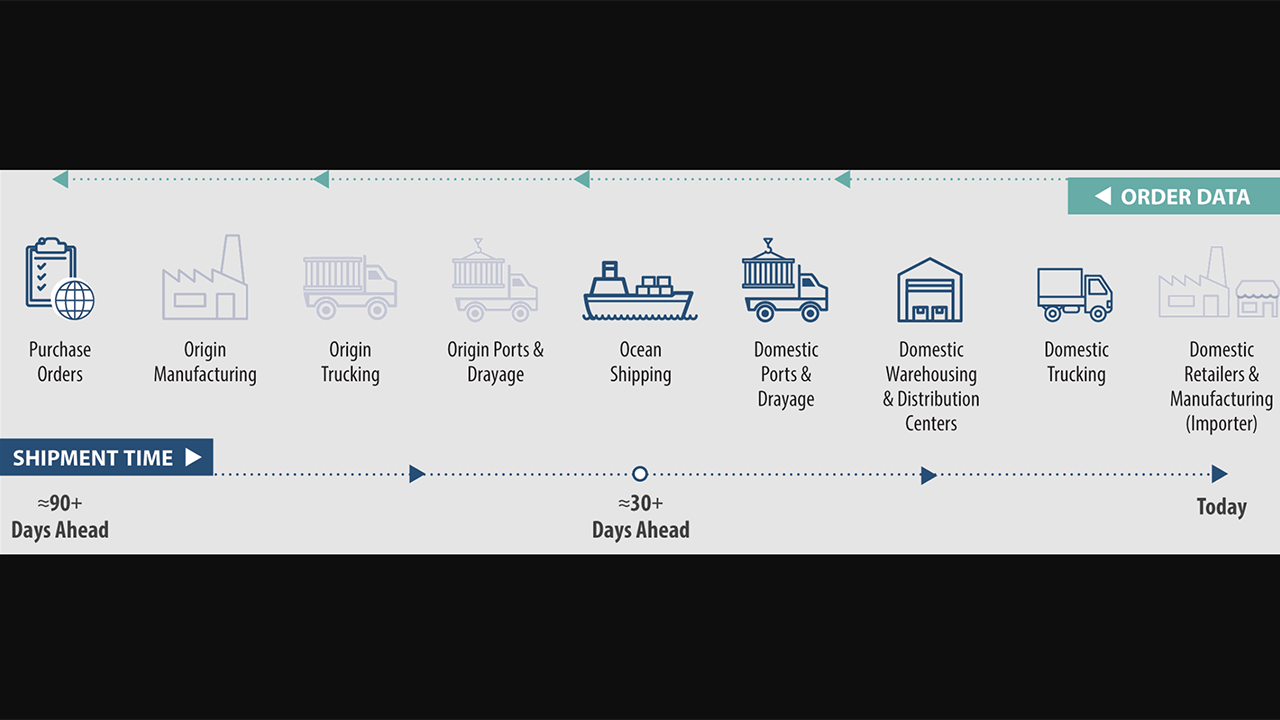
USDOT Marks Milestone on Second Anniversary of FLOW
Written by Marybeth Luczak, Executive Editor
How It Works: FLOW Data Inputs and Outputs—Members of the FLOW program (e.g., beneficial cargo owners, ocean carriers, ports, terminals, railroads) share individual logistics data (highlighted in bold in the graphic above) with the USDOT and in return receive an aggregated, anonymized, and holistic view of the relationship between incoming containers (demand), the available assets to move containers (supply), and throughput within a supply chain region. Incoming demand is shared up to 90 days in advance of arrival. (USDOT Graphic)
The Freight Logistics Optimizations Works (FLOW) platform is now publishing data on inland freight hubs, including rail terminal and warehouse end destination data, that will provide an “enhanced view” of future container import volumes and traffic, the U.S. Department of Transportation (USDOT) reported March 20, the second anniversary of the platform’s launch to provide an integrated view of supply chain conditions in the United States and to help users forecast how current capacity and throughput will fare against future demand.
The new data on inland freight hubs “will help inform capacity decisions and avoid supply chain challenges, such as delays, for FLOW participants that will ultimately help lower costs for consumers,” according to USDOT, which created and leads FLOW, a “first-of-its-kind” private-public partnership whose members include BNSF and Union Pacific; the five largest U.S. container ports; seven of the largest ocean carriers; and nine of the 20 largest retailers by imports. More than 60 companies are in the onboarding process, USDOT said.
How does FLOW work? USDOT collects, aggregates, and anonymizes key information shared by participants on inbound containerized freight, starting with importer purchase orders, and aligns future demand volumes against current regional capacity to move ocean containers. Industry members who join FLOW can access secure data through a shared online portal or API hosted by the Bureau of Transportation Statistics (see graphic, top). USDOT said it actively works with industry members to continue to improve and build use cases with FLOW data, and the partners are also working to use the data “to better estimate port and inland network congestion and monitor cargo shifts due to the Houthi attacks in the Red Sea.”
“In February 2021, President Biden ordered a whole-of-government approach to tackle supply chain disruptions brought on by the COVID-19 pandemic,” USDOT said. “The Administration’s steady efforts to improve supply chains in the short-, medium-, and long-term have lowered costs for consumers and lowered inflation across the economy. A recent analysis from the White House Council of Economic Advisors found that supply chains normalizing in some form explain more than 80% of the disinflation the U.S. has experienced since 2022.”
Industry Weighs In on FLOW
“FLOW provides participants with unprecedented access to supply chain data, empowering our port users with the ability to anticipate potential bouts of congestion,” Port of Los Angeles Executive Director Gene Seroka said. “FLOW has become an invaluable tool to cargo owners seeking to manage their supply chains, and importantly, FLOW has become a safe and trusted repository of supply chain data, opening up possibilities for additional applications to support supply chain resiliency. As one of the nation’s early pioneers in supply chain digitalization, the Port of Los Angeles has been encouraged by the widespread acceptance of supply chain data sharing that Project FLOW has enabled. We see opportunities to leverage FLOW to make our port community system—the Port Optimizer [from Wabtec]—become a more powerful tool for our port customers. Under the leadership of Secretary Buttigieg and the staff at USDOT, FLOW has built a unique public-private partnership that addresses one of the core vulnerabilities of our nation’s supply chains—lack of sufficient data sharing.”
Jesse Whitfield, Director of Global Ocean Freight with UPS commented: “FLOW members are getting more granular views of their supply chain allowing them to consider not only alternate routings but also potential shifts in their distribution networks. That directional insight is invaluable when it comes to being able to pivot during times of disruption. Since this project began, the USDOT staff has been committed to creating a platform that brings visibility to the US supply chain from every view. Consistently listening to the needs and concerns of the members from Day One, they have developed views that help members make the right decisions when it comes to maintaining an efficient flow within their supply chain. Additionally the USDOT leadership has added to their staff to accommodate the growing membership and the needs of this project. It hasn’t just been commitment, it has been the delivery of what matters. The FLOW program can continue to evolve under the USDOT establishing itself as a trusted index not only for US business but also for the supply chain needs of other departments within the US Federal government.”
Noted Dr. Noel Hacegaba, Chief Operating Officer with Port of Long Beach: “FLOW facilitates a secure and seamless process for supply chain stakeholders to share data that provides members with a forward-look on supply chain conditions and the ability to anticipate and adjust to avoid delays … FLOW is a game-changer.”



